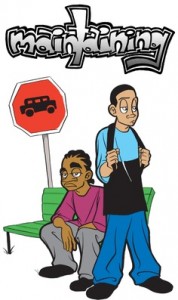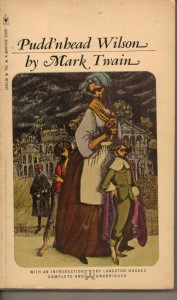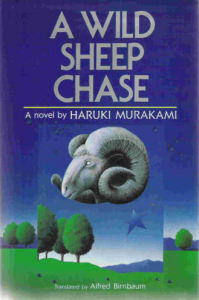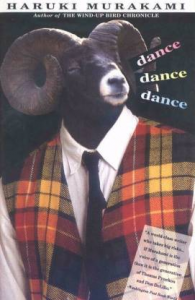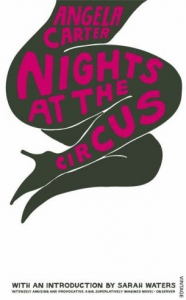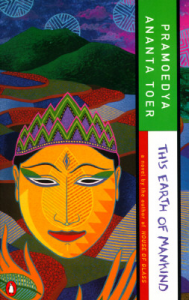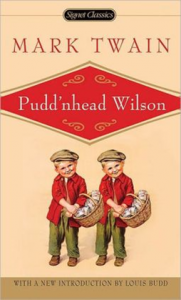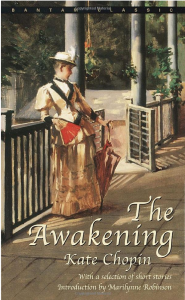Betsy Huang
Quadroon Nurse
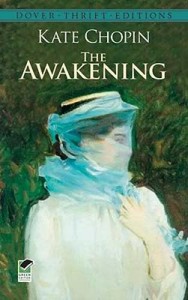
Character: Quadroon Nurse
Source Text: Kate Chopin, The Awakening (1899)
Entry Author: Maraed Dickinson
Racial Mix: Categorized by narrator as “Quadroon,” a term used to designate a person of white and one-quarter African ancestry.
The plot of The Awakening unfolds among a close-knit community of affluent conservative Creoles living in New Orleans during the late 1800s. The novel, coinciding with the early women’s movement, focuses on the increasingly rebellious behavior of Edna Pontellier, who rejects society’s expectations and searches for an identity independent from her role as wife and mother.
As Edna becomes increasingly absent from her prescribed familial role, entering into an affair and eventually moving out of her family home, the Quadroon Nurse performs the role of caretaker and constant companion to Edna’s two young boys. The nurse remains at Edna’s disposal: either to free her of responsibility, allowing her to explore her identity crisis or, be easily dismissed, so Edna can entertain a fantasy of motherly affection for brief periods. Edna can ignore them or, in spurts of focused attention, let off steam from her conflict with Robert by blaming the supposedly negligent quadroon.
The nurse’s effect on the status quo offers some debate. On the one hand, she maintains the status quo and structure of the society by keeping its individual unit, the household, functional despite brewing discontent. Her oppression and resignation to her domestic duties preserves the family. At the same time, the nurse’s compliance frees Edna to explore outside her marriage and her prescribed role in the Creole society. Eventually, Edna’s exploration culminates in her complete breakage from society through her suicide.
The nurse’s ultimate role is to enable the freedom of others, even the two young boys she watches, who exercise their white male privilege despite their young age. Even the youngsters “[look] upon [the quadroon nurse] as a huge encumbrance, only good to button up waists and panties and to brush and part hair; since it seemed to be a law of society that hair must be parted and brushed,” (19). The young boys move about freely with “the quadroon following at the respectful distance which they [require] her to observe,” (30).
At times, the Quadroon Nurse reflects Edna’s discontent from the burden to perform her societal role, but mostly, she absorbs those tensions. The nurse is given little dimensions otherwise. When she leaves, she “vanishe[s],” allowing us no look into her outside life. However, the readers are allowed small glimpses into an internal mental world separated from her domestic duties. The novel introduces her with her customary activity off following the children around but “with a faraway, meditative air,” indicating that her she is not mentally invested in her duties (3). Despite her subservience, the nurse maintains her hidden world of inner thoughts…. At times she “follow[s] them with little quick steps, having assumed a fictitious animation and alacrity for the occasion,” (139).
Unlike affluent white women, her class and race determines that she will always be expected to be capable, and never told she is weak and cannot lift a finger. Her acceptance of her role seems racialized. Complying with Edna’s whim of portrait painting, “the quadroon sat for hours before Edna’s palette, patient as a savage,” (148). Her presence becomes a faint “pursuing voice … lifted in mild protest and entreaty,” mixed with the sounds of the children’s “escaping feet” – a marker of her Sisyphean duties (129).
Roxanne
Character: Roxanna
Source Text: Twain, Mark, and Sidney E. Berger. Pudd’nhead Wilson and Those Extraordinary Twins: An Authoritative Text, Textual Notes, Criticism. New York: Norton, 1980. Print.
Entry Author: Claire Tierney
Roxy is 1/16th black and 15/16ths white in Mark Twain’s Pudd’nhead Wilson, where she is a slave to Percy Driscoll. She is resilient, resourceful, and pragmatic. She is very much a victim of her society and her station in life. She is described as looking white, “to all intents and purposes Roxy was as white as anybody; but the one.sixteenth of her which was black out-voted the other fifteen parts and made her a negro” (9).
She is described as beautiful, “Her complexion was very fair” and her hair was brown, “but it was not apparent because her head was bound about with a checkered handkerchief and the hair was concealed under it” (9). When she is “among her own caste” she had “an easy, independent carriage […] and a high and ‘sassy’ way” (9). But when she was around white people she was “meek and humble” (9). Society defines her as black only because of her tattered clothing and lower-class vernacular. These social constructions, along with her intellect and strength, highlight the fallaciousness of Dawson’s Landing’s definitions of race.
Her sense of morality is constantly in question. Early on the novel when she sees Judge Driscoll has left some money out, she does not take it, thanking the fact that she “was saved in the nick of time by a revival”, saying “‘Dad blame dat revival, I wist it had a ben put off till tomorrow” (12). Later on in the novel her only concern becomes protecting herself and her son. She is willing to do anything for him. She complicates the binary of good and evil, and becomes increasingly darker throughout the novel. This is a direct result of desperation, as she is forced to make decisions more erratically.
She switches Tom and Chambers in their infancy in an effort to save her son the pain of serving the same life sentence of slavery that she has endured. Nevertheless, she enjoys seeing her son, a black man, in a position of power. She actively seeks to change the status quo in her society, and uses her and her son’s multiraciality to do so.
Later when the death of Judge Driscoll frees Roxy, she works hard until her body is arthritic, and she comes back to see her son. She becomes enraged when she sees that her son has become a criminal, squandering the opportunity she gave him by falling prey to society’s spoiling of him. She takes control of his life, demanding that he turn over a part of his allowance to her. She masterminds criminal plans with her son, and he betrays her, selling her “down the river” to an abusive slave master. She escapes by attacking her overseer and returns to Tom, telling him that she will reveal his true identity as a black man if he does not buy her freedom. After Tom fails at doing this, and gets caught in the Murder of Judge Driscoll, Roxy lives the duration of her life with “the spirit in her eye quenched” and “the voice of her laughter ceased in the land” (120). She fulfills the prophecy of the tragic mulatto, forever an outcast to society, forever miserable.
Roxy comports herself with confidence as a beautiful light-skinned woman around black people, and as a lowly ignorant black woman among white people. Her presentation, her vernacular, and even her morality are largely defined by the perceptions of those around her, more than how she defines herself. Despite her pragmatism and attempts at disrupting the status quo, she falls victim to society’s cruel logic.
The Sheep Man
Character: The Sheep Man
Source Text: Murakami, Haruki. A Wild Sheep Chase. Tokyo: Kodansha International, 1989. Print.
Entry Author: Mike Steigman
A WILD SHEEP CHASE
The Sheep Man is believed to be part sheep and part human, he appears out of the blue as an apparition to the main character searching for his friend in the mountains north of the Junitaki township. Interestingly, his mixed identity is quite literally all he has to his name. The “sheep” in “Sheep Man” comes before “man” insinuating he is more animal-like than human. Upon his entrance, Murakami states, “The Sheep Man wore a full sheepskin pulled over his head. The arms and legs were fake and patched on, but his stocky body fit the costume perfectly. The hood was also fake, but the two horned that curled from his crown were absolutely real (251).
He loses his temper with the main character after being questioned too much, but quickly regains his composure. The sheep man then apologizes to the main character because “sometimes it’s like the sheep in him and the human in him are at odds so he gets like that” (254).
He speaks human language, yet all of his sentences in the narrative are void of any spaces or capitalization, so it’s difficult to distinguish one word from another. One can say his words sound like animal noises in this sense. His basic qualities are reminiscent of a Neanderthal. He is attentive to polite behavior, yet flees at the first sign of violence, even metaphorical like when the protagonist raises his voice. The main character goes further to say, “The sheep man was just like an animal. Approach him and he’d retreat, move away and he’d come closer. As long as I wasn’t going anywhere, there was no hurry” (254). By being part-animal, the Sheep Man is unable to form any emotional ties with the protagonist, therefore further isolating both the main character as well as himself.
Murakami deliberately chooses to blend this man with a sheep in order to extract some of his humanity and highlight his weaknesses. The Sheep Man reveals the reason he hides out in the wilderness is because he didn’t want to go off to war, because members of the Junitaki Township went off to fight in the Russo-Japanese war. He claims he didn’t know who he would be fighting, he just knows he didn’t want to go. And “that’s why he’s a sheep.”
However, there’s a distinct binary evident in partially being a sheep. Sheep are herded by one person, with all their choices made for them by the shepherd. Once divided from the flock, a sheep is left with little direction. Animals are also typically perceived as strong, unstable, wild creatures. Centaurs and lycanthropes, part human and part animal, are mystical creatures, wise and fierce beyond human capabilities. Murakami plays with this notion while simultaneously categorizing, in his name, a mixed-race/species character, arguing that a double identity can weaken one’s abilities just as it can fortify them.
Lastly, The Sheep Man tells the protagonist, who had originally traveled to the Junitaki Township with his girlfriend had forced her to return to the Dolphin Hotel. He assures the protagonist that she didn’t want to be there and she doesn’t belong. The Sheep Man disappears as quickly as he entered in the novel, without explanation.
DANCE, DANCE, DANCE
The Sheep Man reappears in this novel, along with the main character. His mask has become grungy, his horns dilapidated, and he looks significantly older. This time, the Sheep Man appears where he had supposedly sent the main character’s girlfriend in A Wild Sheep Chase, the Dolphin Hotel. The main character presses a button in the elevator, and suddenly it opens its doors on a floor, pitch-black. The elevator refuses to move, so the main character exits to the floor and finds The Sheep Man sitting behind a desk. The Sheep Man speaks in the second person, constantly asking the narrator to tell “us” what’s going on outside as “we” want to know.
The Sheep Man’s costume appears more dingy than “last time”, his stature shorter and his breathing heavier. He advises the main character that he has to dance and keep on dancing, that is the only way to not lose direction.
Toward the end of the novel, the main character visits The Sheep Man together with Yumiyoshi, his girlfriend, but The Sheep Man has vanished. Reminiscent of A Wild Sheep Chase, The Sheep Man appears unable to exist alongside a partner of the protagonist. All that remains are clippings and yellowing pages about sheep that The Sheep Man had been guarding. They are now abandoned with no one to care for them. Having lived away from war and civilization, The Sheep Man grows older and older until he disappears into irrelevance, with any hope of peace from future wars disappearing along with him.
Sophie Fevvers
Character: Sophie Fevvers
Source Text: Carter, Angela. Nights at the Circus. New York: Penguin, 1984.
Entry Author: Alexandra Katechis
Fevvers
A found AbecedarianAnatomy of our avian wonder, aerialiste extroidinare:
Azrael, Azrail, Ashriel, Azriel, Azaril, Gabriel,Broken blossom of the present tense. Fevvers,
Brothel-bred burlesque of Brobdingnagian symmetry, aChorus of a woman, cheering on the coming century, the
Circus of our Cockney ringmaster, celestial fishwife,Dark angel of many names, and all the rest of this dolorous litany. We, the
Denizens of down below, all with hearts that beat and souls that suffer, sir,Excavated from England, once held above the spinning world,
Effervescent and eager, now dropped back into place. Think twice about turningFrom a freak into a woman, the female part where Terror rules. Our
Feathered friend advises the fool with festering teeth. FevversGroks with a joyous awe, almost a gratitude, that luxury should exist like
Gin palaces in heaven where she might reside behind the barHemmed in the heavy envelope of simplest delusion. Walser and
His hobby of the humbug hunt, hung up with her on the high trapeze.Is she fiction or is she fact? The idea of it condemns them both.
I feared the proof of my own singularity, and no longer alone, theyJoin in with the stable-boys, roustabouts and grooms, elephants and equestrians,
Jugglers and tumblers, all drawn to the amazing spectacle, all succumbed to it.Knowing no other tricks, the circus could absorb madness and slaughter, and
Knit together the hypnotic tension between the flesh and the spirit.Lovely London, the shining city, the new Jerusalem,
Lit with candles of midnight, burns up the nuclear core of our luciferity:Magic, the museum of women monsters, made pure in
Midsummer, yes, the year’s green hinge.Once and for all, find the oracular proof in the organ of this gilded cage, and
One by one we might be made free from thisPanopticon, step from our platforms of prolegomena and slowly, slowly begin to
pull, dragging with us our freight of dreams. With a pressureQueer as combustion and composure of equal and celebratory
Quality, she proclaims, all the women will have wings, the same as I. TheRhapsodic rush of the interrogatory, What is your name? Have you a soul? Can you love?
Requiem for her dazzling reflection, restorer of her soul. We rise from aSleep more lifelike than living which consumes the world, the
shaman’s elixir coaxed out of the samovar with sulfurictongues. We are abandoned between tundra and taiga in our mind’s
Transbaikalia, steeped in the bliss of a new century. Fevvers, theUniversal word of wonder, of grief, cracks the black, black vortex of the
Uroboric snake with its tail in its mouth. Once theVerified and venerated virgin whore, channel of volcanic sighs; now a miracle of frail
Violets, frost nipped and pale, the colour of tired eyelids yet bigWith wilderness and wildness, in full bloom…Violets on New Years Eve.
Wherever we go we’ll need no more fathers, her heart crushing with commotion andExpectation of pleasure. Once the old world has turned on its axis,
exacerbated with the customary endings of the old comedies,You shall give yourself to me but I shall not possess you.
Year One, the envoi of this extensive ritual;Zed to this linear story which seemed to happen in the third person
Annelies Mellema
Character: Annelis Mellma
Source Text: Toer, Pramoedya Ananta This Earth of Mankind
Entry Author: Mike Steigman
Annelies Mellema is the illegitimate daughter of Dutch settler, Herman Mellema, and Javanese (Indonesian) Concubine, Nyai Ontosoroh. She is the sister of Robert Suurhoff. Both he and Annelies are part Javanese, part Dutch or “Mixed-blood”, as referred to in the novel. Both Mr. Mellema and Nyai rushed to board a ship when she was in labor so Robert could be born a Dutch citizen, but to no avail.
Annelies’ introduction begins thus, “In front of us stood a girl, white-skinned, refined, European face, hair and eyes of a Native” (25). Her description is told through Minke, the protagonist’s perspective. Minke is Javanese, yet fluent in Dutch and Western studies thanks to his schooling. Annelies on the other hand stays home, assisting her mother in working the fields and raising animals.
She acts incredibly childish throughout the narrative, with all decisions imposed upon her. mother, love interest, father, doctor and brother all and forcibly make decisions for her. Her will is frail and she falls ill at the slightest touch, namely without Minke’s presence, continually drugged by the family doctor until Minke returns to her.
Once she wakes up from being drugged, the doctor tells Minke to “‘Have pity on this child. She cannot face violence or harshness. She dreams of someone who will love her, who will give her pure love. She feels like she is living alone, by herself, without knowing the world’” (202).
Considered the “better child” between herself, and her mixed brother Robert Mellema, she maintains the farm with her mother, Nyai. Robert Mellema had also dropped out of school and “for him there would be nothing greater than to become a European and for all Natives to bow down to him (67). He desires to pass as Dutch, but is unable to do so due to lack of education and his darker skin color. Annelies leans toward her Javanese identity based off her close relationship with her mother. Nyai has told her stories about how Herman Mellema had slowly turned an incredibly evil man after Nyai had attempted to educate herself to be fluent in Dutch and Western studies. Ever since, Nyai has decided to keep Annelies out of schools. Coupled with Robert Mellema sexually assaulting her, Annelies wants nothing to do with her “Dutch” side of the family.
Before he and Nyai had met, Herman Mellema was married and had a son. His biological son visits and accuses him of having “committed a blood sin, a crime against blood” (99).
The text concludes with her forced departure from Java, being the illegitimate wife of the main character and the illegitimate daughter of Nyai in the eyes of Dutch law. The courts then decide to send her off to Europe. Once she exits the safe haven of her home, she leaves Nyai and the main character, the two natives or Dutch-educated “pure-bloods” alone in the house, newly confiscated by the government.
The first installment in the Buru Quartet, This Earth of Mankind was originally an oral story shared between Indonesian prisoners. When Pramoedya Ananta Toer transcribed the text to paper, he sought to ‘correct the accepted version of the history of the ride of Indonesian nationalism’ through Annelies, who embodies the frailty of the nation, the instability of relationships as a counterpart to Minke and Nyai, both pure-blood Natives well-versed in Dutch teachings yet rendered powerless.
Annelies’ weakness is a microcosm of the relationship between colonizer and colonized. As an involuntary ambassador of the tragic princess, the walking manifestation of the union between ‘civilization’ and ‘barbarism’, she is wiped out by the end of the novel. As she exits, any hope of reconciliation between the Natives and the Dutch is systematically erased.
Tom Driscoll (Valet de Chambre)
Character: Tom Driscoll (Valet de Chambre)
Source Text: Mark Twain, The Tragedy of Pudd’nhead Wilson (1894)
Entry Author: Adam Kelley
The character known throughout the text of Puddn’head Wilson as Tom Driscoll, a white southern aristocrat, was actually born Valet de Chambre, a mixed race child born a slave, but was switched at birth by his slave mother Roxana, “Roxy”. Chambers, hereafter referred to as Tom, ‘passes’ as the son of Judge Driscoll, descended from the “First Families” of aristocratic “Old Virginia” lineage. Tom’s real identity is later revealed using forensic evidence that proves his birth, but his appearance and success as an imposter challenge 19th century notions of racial identity. Tom, is born a ‘black’ slave by the ‘one drop’ rule, lives half his life as free white man of a locally respected family, and is ultimately revealed and sold back into slavery. The irony of his fate draws out the arbitrary nature of socially and legally constructed racial identity.
The imposter Tom’s race is known through his mixed race mother Roxy. The narrator describes her as “white as anybody, but the one sixteenth of her which was black out voted the other fifteen parts and made her a negro” (Twain 9). Twain’s matter-of-fact tone parodies the absurd nature of 19th century legal definitions of race. He presses this point farther when he describes of Roxy’s son that “he was thirty-one parts white, and he, too, was a slave, and by a fiction of law and custom a negro” (9). Both Roxy’s and her child’s racial status is defined legally in terms of the “one drop rule” that defines them as slaves by descent.
Physically, Roxy’s son ‘Chambers’ and the child Tom Driscoll appear identical. Twain describes of Chambers that “he had blue eyes and flaxen curls, like his white comrade” (9). The only discernable marker between the two infants is their clothing: the Driscoll child dressed in the finest garb and ornament, and Chambers stuffed into a “course” shirt that “barely reached his knees” (9). This further links the racial identity of the children to social cues imbedded in status symbols, and not in anything inherent in the children themselves.
Later in life the imposter Tom is informed by his mother that he was switched at birth and this has a devastating effect on his sense of self. After the revelation he wakes in the morning to exclaim the infamous lines “‘A nigger!—I am a nigger!—oh, I wish I was dead!’” (48). Profoundly disturbed by the news of his origin, Tom’s personality is shattered and he immediately begins to internalize the racial stereotypes he once cast on others. He feels “the curse of Ham upon him” (49) and “the ‘nigger’ in him was ashamed to sit at the white folks table” (49). He becomes deeply aware of his vulnerability under the law, and lives his life in constant fear of being found out.
All of Tom’s social relationships become inverted: his mother, once his slave, now lords her secret knowledge of his identity over him, and his perception of his relationship to his Uncle and his community alters drastically from entitlement to suspicion. His drastic shift in mood draws out the effects of racial prejudice on the marginalized of society. Tom is unwittingly forced into the position of ‘passing’ as white, and grows up oblivious of his origin. But, once he learns his true origin, he immediately begins to question his own identity and alters his personality and behavior. Nevertheless, Tom is consistently a despicable character: callous, cruel, and manipulative, but his punishment of being “sold down the river” feels unjust even for such an unlikable person. Tom, although being guilty of multiple counts of theft and even a murder, is ultimately punished merely for being a fraction ‘negro’.
Armand Aubigny
Source Text: Chopin, Kate. The Awakening: With a Selection of Short Stories. 1899. Reprint. New York City: Bantam Dell, 1981. 177-182. Print.
Entry Author: Emma Baker
In Kate Chopin’s short story, “Desiree’s Baby,” Armand Aubigny is the father of the titular child and the husband of Desiree. Belonging to a well-known, respectable Creole family, he owns a plantation called L’Abri that he inherited from his father. He spent his childhood in Paris until his mother’s death, and returned home to the United States with his father. Presumably, he lived with his mother when she was still alive. His role in the short story focuses on falling in love with Desiree, the adopted daughter of the Valmondés, another well-known creole family. Although Desiree comes from an ‘obscure origin,’ as the Valmondés found her around the ‘toddling age’ near the gateway to their home, Armand initially finds that no obstacle to marriage instead asserting, “What did it matter about a name when he could give her one of the oldest and proudest in Louisiana?” However, while his father treated the slaves under his ownership with kindness, “Young Aubigny’s rule was a strict one, too, and under it his negroes had forgotten how to be gay.” (Chopin, 177)
As such, Chopin positions Armand Aubigny as the character with the most power in his societal context. He is male, wealthy, and at the start of the story, both the reader and the surrounding characters believe he is white. One can see evidence of his exercise of this power in the treatment of his slaves as well as evidence of prejudice and racism. He seems reasonable in his acceptance of a nameless wife whose origins are unknown at the start of the novel, but after the birth of their child one perceives changes in his behavior. Others notice the child’s skin tone before he does but he begins to absent “himself from home; and when there, avoided [Desiree’s] presence and that of her child, without excuse.” (Chopin, 179) After Desiree herself realizes the similarity to one of the quadroon boys of La Blanche, a mulatto slave, she pleads with Armand to tell her what it means. He only responds, “it means…that the child is not white; it means that you are not white.” (Chopin, 180) Armand is not suspected to be the reason for the child’s quadroon appearance, as Desiree’s origin is unknown. As she attempts to defend herself by naming her features, he cruelly responds, “As white as La Blanche,” (Chopin, 180) demonstrating that the physical appearance of whiteness holds no power when one carries ‘black blood.’ Following this, he draws further away from his wife, begins to treat his slaves with a greater cruelty than before and does not prevent his wife from walking unprotected into the bayou with her child never to return. His position in a place of power demonstrates how influential his actions and decisions are on the lives of others around him, as well as highlight the discrepancy between an unknown origin or namelessness and the possibility of having black ancestry.
Chopin does not reveal his parentage until the last lines of the story. As he burns all of Desiree’s belongings he finds a letter sent from his mother to his father saying, “I thank the good God for having so arranged our lives that our dear Armand will never know that his mother, who adores him, belongs to the race that is cursed with the brand of slavery.” (Chopin, 182) The reader then retroactively remembers various mentions throughout the story of “Armand’s dark, handsome face,” (Chopin, 179) and when Desiree pleads, “look at my hand; whiter than yours, Armand.” (Chopin, 180) As such, Chopin constructs Armand as a mixed race character who passes for white and maintains, if not enforces, the status quo in order to demonstrate the hypocrisy of the Louisiana culture. In the revelation of his mixed race as the final and pivotal plot-point, Chopin upsets the status quo by suggesting a complete lack of adherence throughout the piece, as well as emphasizing the dire consequences that resulted from adherence to those conventions.

